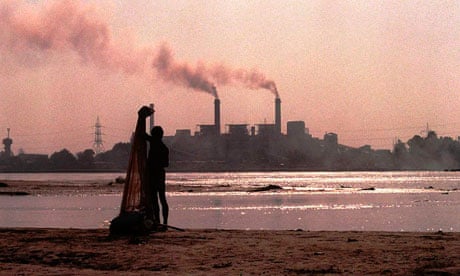The city of the Red Fort, the Jama Masjid, the Gate of India and the 12th century Qutb Minar tower is to get a new monument. A decommissioned power station in Delhi, the Indian capital, is to be converted into an art gallery modelled on London's Tate Modern.
The plan has been approved by Delhi municipal authorities, the Times of India newspaper reported , and could be completed in three to five years, depending on how long it takes to dismantle parts of the Indraprastha power plant beside the banks of the Yamuna river.
The cost of the project is currently "fluid", a municipal planning official told the newspaper, but could run up to £70m. "Worldwide there are many examples of adaptive reuse of industrial buildings and power plants. We will retrofit technology to make the museum," the official said.
The 60-acre site will also be used for offices and will be connected to the city's new metro, currently in its third phase of expansion. Solar panels will provide power, and other energy-conserving measures, such as a roof garden, are planned to reduce emissions from the new complex in one of the most polluted cities in the world.
A sixth of the site will be reserved for a forest.
Quite whether the ambitious plan will be executed is uncertain. It was reported in October that the 33-year-old plant, Delhi's oldest, would be demolished and a vast multistorey car park built instead. Car use in the city has quadrupled in 10 years and parking is a major problem. No mention of an art gallery was made.
The site of the new project, a hundred metres from the river, also brings its own problems. Museum-goers would probably find their enjoyment of the gallery ruined by the infamous stench from the Yamuna, especially during the hot summer months.
The river currently receives untreated solid waste from around 9 million people – half the population of the city – as well as vast quantities of industrial pollutants.
That the idea has been floated at all, however, is evidence of the growing interest in contemporary and modern art in India.
Earlier this month an exhibition of works by Anish Kapoor, the Indian-born, UK-based sculptor, opened simultaneously at the newly refurbished National Museum of Modern Art in Delhi and at Mehboob Studios in the Indian commercial capital of Mumbai.
Sonia Gandhi, president of the Congress party and widely considered the most powerful person in the country, inaugurated the show, which has gone on to be one of the most popular in many years.
"The interest in India is definitely there for both Indian and overseas art. Delhi is where it is happening in India in terms of art infrastructure and an active art scene now," said Parul Vadehra, director of the private Vadehra Art Gallery in the Indian capital.
There is also a growing international interest in Indian art. A series of major shows of contemporary Indian artists are planned in Europe this summer, including at the Pompidou Centre in Paris. Indian art is also fetching high prices at auction. A work by the major Indian modernist SH Raza fetched £2.7m last June, a record for a modern Indian work.
